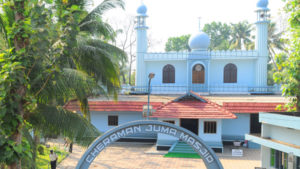Said to be India’s oldest mosque, Cheraaman Jumah Masjid (also spelt as Cheraman) is located in Methala, Kodungallur in the Thrissur district of Kerala. A legend claims that it was built in 629 CE, during the lifetime of the Prophet Mohammad, thereby making it the oldest mosque, still in use, in the Indian sub-continent. Unlike other mosques who face west towards Mecca, Cheraman masjid may be the only one to face towards the East.
It was built by Malik Deenar, a Persian tābi‘ūn (follower) of the ‘Companions of the Prophet’, on the orders of Cheraman Perumal (Perumal, being the title for the Chera kings). Numerous legends about Cheraman Perumals associate them with the development of the Kollam or Malayalam era and Onam, among other important cultural landmarks.
While debates rage on whether this legend is factual, a curious aspect of the architecture makes it, partly true. The masjid was made in the Kerala style of architecture with hanging lamps. Given the timeline, it must be noted that early Islamic architecture in Kerala did not exhibit the Arabic style or the syncretic Indo-Islamic architectural elements of North India. And why so?
Mosque construction was mostly done by the local Hindu artisans who worked for the Muslim religious clerics; they wanted to erect places of worship. Hence, the early mosques of Kerala resemble the prevailing traditional buildings of the region. For the Muslims who had settled in the region, Hindu temples or the theatre halls (known as koothambalam) became models to observe and incorporate within the emerging architectural trends. The other important historical aspect is trade. The Arabian Peninsula (the cradle of Islam) had direct trade relationship with Kerala coast right from pre-Islamic times.

One version of the legend states that while walking with his queen in the palace one day, the Chera king witnessed the moon splitting in half. Shocked, he asked his astronomers to note the exact time of this event. When Arab traders paid him a visit, he narrated the story. They told him about the Prophet Mohammad’s miracle. In another version, the king saw the moon in a dream.
He gave up his throne and divided his kingdom between various chieftains; a political move to ensure strong governance. As per the legend, he converted to Islam and met the Prophet during his pilgrimage to Mecca. He wrote letters to his relatives back at home, stating that they should be courteous towards Malik Deenar. He passed his remaining years in Arabia as a devout Muslim.
A Brahmin text written in Malayalam, by the name of Keralolpathi mentions a story of a Chera ruler embracing Islam.
Renovation of the mosque took place thrice – 11th, 16th and 20th centuries. Modern corridors and halls have been added which surround and conceal the exterior of the old building.
The legend of the Cheraman Jumah Masjid celebrates the secular ethos of the Indian sub-continent, one that continues from times immemorial. Even today, people from all faiths visit the mosque.



